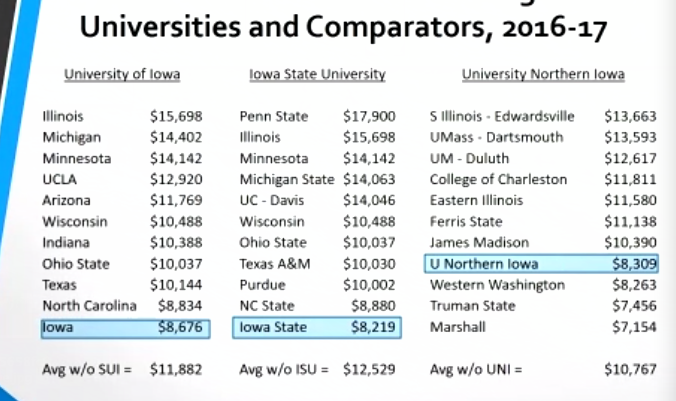Regents approve tuition increase for 2017-18
Toutkoushian’s presentation included data from the three regent universities.
June 7, 2017
The Iowa Board of Regents approved a tuition increase to all three regent universities at a regular meeting Thursday.
Tuition will increase an additional $216 dollars for each student at Iowa State University. The increase is to improve the original “two and two” tuition system, which suggested a two percent increase every two years accompanied by a two percent increase in state appropriations.
With funding cuts from the state, the Regents chose to raise tuition to cover the loss. A Tuition Task Force will also be formed to look at long-term tuition options.
It was a second reading of the tuition rates, which appeared before the board in early May. No questions were asked or discussion had on the tuition rates this round. The motion was approved unanimously by the Regents present.
The new tuition totals come to:
Resident undergraduates: $7456 (5 percent increase from 2016-17)
Non-resident undergraduates: $21,292 (4.1 percent increase from 2016-17)
Resident graduates: $8944 (5.5 percent increase from 2016-17)
Non-resident graduates: $22,656 (4 percent increase from 2016-17)
@IowaRegents is voting on these increases this morning. Stay informed, Iowa State. pic.twitter.com/Un3B1gvPCH
— ISU Student Gov (@ISUStuGov) June 8, 2017
Forming a Tuition Task Force was discussed, with more meetings to come over the summer with workforce representatives, institution representatives and legislation representatives.
Dr. Robert K. Toutkoushian, currently a professor in the Institute of Higher Education at the University of Georgia, has a doctorate in economics, and spoke to the Regents on what to consider when looking at tuition increases.
The growth in enrollment has been at the undergraduate level for the Iowa regent universities, and high school graduate projections show Iowa is expected to increase between 3 and 10 percent, but many of the states to the west will increase by more than 10 percent because of population growth. This could lead to higher enrollment demands.
Tuition isn’t rising because of rising costs, necessarily, but loss of funding. State subsidies fell from about 11 percent to about 6 percent – nearly half.
“The burden for paying for higher education is shifting from government to students.”
That was Toutkoushian’s main message.
In 2008, tuition and government switched. Before 2008, the government supplied most of the funding to higher education; now it’s tuition.
That raise in tuition has three potential impacts: Students stay and pay the new price, some students leave and some students who would have enrolled cannot or will not. Any loss of students is a decrease in funding. It isn’t as simple as raising a percentage and receiving that percentage.
Toutkoushian did say Iowa’s prices are competitive. The gross prices are generally lower than peer institutions for each regent university.
Institutions want to set prices, generally, to run operations, to enroll enough students to do what the institution wants to do and to enroll a mixture of students.
Revenues minus expenditures equals net margin. It’s basic economics, and for public not-for-profit institutions, net margins should average close to zero.
Revenues are what fluctuate more than expenditures, particularly in state funding and private donations. It also tends to come at certain times of the year, when students first enroll in the Fall and when the state gives its appropriation.
Most sources of revenue can be traced back to people, not business entities – so the state government may be looking at economic development and state benefits, but individuals are looking at personal benefit. As more of the pie comes from individuals, more of what the money is used for will reflect what those individuals want.
Loss of state funding can be viewed as the state putting less emphasis on the importance of higher education and supporting students to stay in state to benefit the state economy and job market.
Iowa State University and the University of Northern Iowa chose to apply increases to all students equally. The University of Iowa added additional increases to out-of-state students.
“We believe this sends a powerful message to the State legislature that we are no longer going to give the break to resident students if our state government continues to show that higher education is not a priority,” Iowa State Student Government President Cody West said to the Regents in May. “It is, however, overlooked how much this will truly impact Iowa State students in the fall.”
West was talking specifically about this increase coming on top of the 2 percent increase in tuition that was approved last December.
“That, coupled with new differential tuition for a number of programs and the second phase of the international tuition increase, makes this increase unbearable for some,” West said. “Some classifications could face up to a 15% increase from last semester.”







